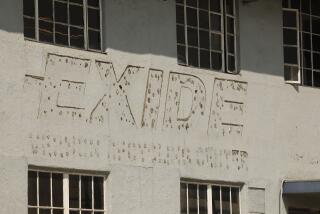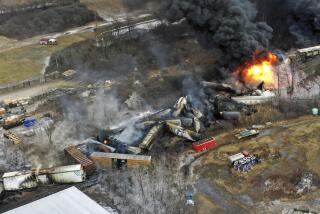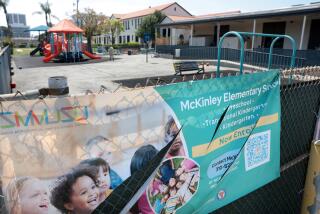Cleanup of Toxic Spill Bogs Down : Derailment: Officials now say they don’t know when U.S. 101 north of Ventura will be reopened.
- Share via
SEACLIFF — Efforts to clean up the toxic wreckage of a Southern Pacific freight train remained bogged down Wednesday and officials said they have given up even trying to guess when a 10-mile stretch of U.S. 101 will be reopened and residents of 49 evacuated houses will be allowed to go home.
Late in the day, workers in bulky, white protective suits began packing 53 undamaged 55-gallon drums of the poisonous chemical hydrazine, a probable carcinogen, into larger barrels. They then sealed the barrels and lifted them out of the tangled mass of freight cars crushed in a 12-car derailment Sunday.
But the work was slow. Ventura County fire officials estimated that they could pack only five drums per hour into polyurethane barrels and remove them from the tracks by crane to be returned to their manufacturer, Olin Chemical of Lake Charles, La.
“To put together a plan took most of the afternoon,” said Michael Lindbery, spokesman for the fire department. “We’ve got a lot of different agencies here and sometimes it takes a long time to agree on a plan.”
Mike Furtney, a Southern Pacific official, said the cleanup workers have moved slowly for safety’s sake.
“While we want to get the residents back in their houses and the highway reopened, we’re not going to put one guy from Southern Pacific or OHM at risk,” he said. OHM Corp. Environmental Service is the company the railroad is paying to clean up the spill.
The packing of undamaged hydrazine drums was expected to continue into Thursday.
On Tuesday, workers sprayed an 8% solution of calcium hypochlorite, or swimming pool bleach, onto the debris and a quarter-acre of contaminated ground, sending a toxic plume of hydrogen and ammonium gas 150 feet into the air. The plume dissipated harmlessly, said Terrence Gilday, county environmental officer.
Officials said they cannot reopen the freeway until they neutralize remaining “hot spots” of tainted ground and debris, and Caltrans officials certify that the highway overpass at the site is safe.
While the workers packed the barrels, a job first planned for Tuesday, traffic rerouted from the coastal freeway continued to snake along twisting mountain roads through rural Ventura County. Trains traveled along inland detours.
Residents complained that the rerouted vehicles, which California Highway Patrol officials say have more than tripled traffic on local roads, is affecting their daily lives.
“Our orchard was full of campers Monday morning, and as soon as people saw they were passing through an orchard, they used it for a bathroom,” said Rincon Valley rancher Duncan Abbott.
Abbott said traffic has blocked his driveway so frequently that he and his family bicycle four miles north to Carpinteria to buy groceries, rather than go by car.
Meanwhile, investigators from the National Transportation Safety Board found the ruined wheel assembly from the 17th car of the 42-car train, which they believe caused the derailment.
“The end of the axle just twisted off,” said Bob Campbell, a safety board rail inspector. “That was our smoking gun.”
Four miles to the south and two days earlier, investigators found the burned-out roller bearing that they believe seized, causing the axle end to twist off and drop the car’s undercarriage onto the tracks, Campbell said. Investigators plan to send the wheel assembly to their laboratory in Washington for tests, he said.
Asked whether the recent spate of rail crashes--particularly the Southern Pacific derailments in Dunsmuir in Northern California and Seacliff--indicated an overall failure to maintain safety by the industry, Campbell said, “I’ve looked at this, and I see a good railroad. I see a well-maintained railroad.”
Times staff writer Adrianne Goodman and correspondent Thia Bell contributed to this story.
Cleaning Up the Train Wreck
When a Southern Pacific train derailed on Sunday at Seacliff, eight 55-gallon drums containing the toxic chemical hydrazine were spilled, over an area of about 100 feet square. At the same time, 15 similar drums were punctured or cracked. Workers, clothed in cumbersome protective suits and breathing apparatus, have been working to clean up the site:
THE PROCESS
1. Vacuuming: On Tuesday, the hydrazine was sucked out of the 15 ruptured drums using a stinger, similar to a giant metal hypodermic needle. The needle is jammed into the drum, and the hydrazine is removed by vacuum hose into a stainless steel truck.
2. Neutralizing: An 8% solution of calcium hypochlorite--essentially swimming pool chlorine--was sprayed over the contaminated area to neutralize the hydrazine, causing a 150-foot cloud of hydrogen gas and ammonia. Underneath the wreckage, there may still be hot spots.
3. Overpacking: The 12-hour process of “overpacking,” which involves putting the unruptured drums into oversized plastic barrels, has started. Those will be sealed and then lifted out by crane onto the freeway overpass.
4. Disposal: The barrels will be returned to the manufacturer in Louisiana.
REMAINING CONCERNS
There are two natural gas pipelines, running parallel to the tracks, about 36 to 48 inches underground. Heavy cranes that will move the train wreckage could rupture these gas lines.
About 60 feet away is a cargo container with 5,000 gallons of naphthalene, a solvent. If by some chance that mixed with hydrazine, it would ignite and could explode.
Although experts minimize the danger, chemical leakage into the ocean could kill come marine life.
THE COST: At least $50,000 a day for the hazardous materials team and county emergency workers.
More to Read
Sign up for Essential California
The most important California stories and recommendations in your inbox every morning.
You may occasionally receive promotional content from the Los Angeles Times.










